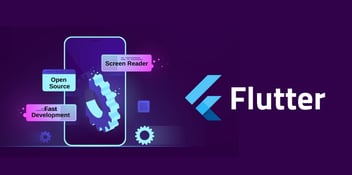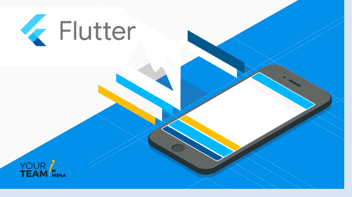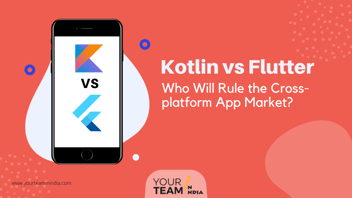Note: This blog was originally published on 13th September 2022 and updated on 27th March 2023.
Quick Summary:
The topic "Flutter vs PWA – Which One is the Best Choice for Your Business?" discusses the pros and cons of two popular technologies used for building mobile applications. The article evaluates the strengths and weaknesses of each technology and provides guidance for businesses to determine which one is the best fit for their specific needs.
Introduction to Flutter Vs PWA:
A decade ago, building mobile apps was a costly affair. You only had the choice of building native apps that demanded thousands of dollars. But now, technology has changed everything by leaps and bounds.
Cross-platform frameworks are rising.
The kind of value they add while building a cross-platform mobile app makes them even more interesting. Not only is it beneficial for businesses in terms of the cost, but also reduces the efforts of developers by allowing them to code once & deploy it on multiple operating systems.
Though there are a lot of frameworks available to build cross-platform applications, Flutter and PWA are the best. And that’s where most entrepreneurs get confused.
What is the main difference between Flutter and PWA?
The main difference between Flutter and PWA is their approach: Flutter is a UI toolkit for creating native-like, cross-platform apps with consistent user experiences, whereas PWA focuses on web-based applications delivering app-like functionality, resource efficiency, and offline access.
So, in this article, we will demystify the conclusion by comparing Flutter vs PWA in detail. However, before making the comparison, let us understand the basics of both frameworks.
Key Takeaways for Flutter Vs PWA
- Flutter is good for complex apps, and PWA is better for simple ones.
- Flutter offers a better user experience, and PWA is more accessible.
- Flutter requires more resources and development time than PWA.
- The choice between Flutter and PWA depends on the business's needs and goals.
What is Flutter?

Without even knowing it, you probably are already using the apps made with Flutter. Have you bought anything from Alibaba? Are you running a campaign on Google Ads? Do you watch videos on Voot or have booked a cab via Ola?
If yes, then you have already witnessed the Flutter apps.
This framework has remained beta for a very long time. With its stable release, there is a lot of excitement about the new transformative technology for the developers. Within a short time, Flutter has become very popular on GitHub and has gathered plenty of stars.
How Flutter is Setting the New Trend in Mobile App Development?
Flutter is Google’s new open-source technology that has the ability to create native Android and iOS apps with the help of a single code base. To be precise, Flutter is not a framework, but a comprehensive SDK i.e. software development kit.
Google offers a development kit allowing Flutter developers to create 2D mobile apps. This particular kit is also used to develop full-featured apps supporting storage, geolocation, cameras, and more.
This means it already has everything that you need to build the cross-platform application. It includes a rendering engine, readymade widgets, and options to test and integrate APIs.
You will be surprised to know that Flutter follows the React-native development architecture but with a twist. The user-interface contents are automatically updated once the variables are updated in the code.
Whereas, Flutter’s object-oriented language is Dart, which uses (AOT) Ahead-of-Time compilation techniques and complies with the native code without any additional bridge. This speeds up the app startup time.
Know the difference between React Native vs Flutter
Debugging takes place in Flutter, and all the credit goes to Dart. The Dart Analyzer and Dart Observatory tools find errors with the help of specific commands. There is another method that includes Flutter-supported IDEs and debuggers. As Flutter doesn’t use a web view, it won’t debug directly in a browser like Ionic.
Moreover, being a comprehensive SDK, Flutter offers an automated testing toolset that allows developers to perform unit testing, widget testing, and integration testing easily.
Why Flutter For Cross-Platform Mobile Apps?

Indeed, Flutter has proven its worth in a short span of time. The framework is being utilized by industry leaders and has matured enough to build enterprise-level applications.
To give you a better understanding, let’s take a look at some of its best features;
1. Faster Development
Choosing Flutter to build your cross-platform mobile application means you can reduce the development time to half in comparison to building native apps and one-quarter less in comparison to other cross-platform frameworks in your mobile development company.
Here’s how;
- Single Codebase – Flutter allows developers to write the code once, compile it using Dart, and run it on multiple operating systems.
- App Testing – Because of a single codebase, you only have to perform the app testing on one operating system.
- Updates – Releasing a new version of the app is quite easy. Again, due to the single codebase, Flutter developers can release app updates simultaneously on multiple operating systems.
- Hot Reloading – Experimenting with your app, adding new features, and fixing bugs become easy with sub-second to reload times, without losing state on emulators, simulators, and hardware.
Therefore, in practical terms, you can save up to 50% of your development cost and time by choosing Flutter over the Native apps and around 30-40% over other cross-platform frameworks.
2. Ready-Made Custom Widgets
One of the revolutionary things about Flutter as technology is that it lets you build beautiful and expressive user interfaces without much effort. Flutter has a consistent and unified object model, having a wide variety of widgets available in its arsenal.
Ranging from Cupertino (iOS style widgets) to material components, animation & motion APIs to styling, text, painting & effects, the Flutter widget catalog has it all. By utilizing the layered architecture, this UI toolkit allows you to fully customize your cross-platform mobile app. As a result, you can render the app faster and build flexible UI/UX.
3. Perform Like Native-Apps
According to Flutter, it aims to provide 60 frames per second (fps) performance or 120 fps performance on devices capable of 120Hz updates. This simply means it is possible to build high-performance apps for both iOS and Android using Flutter.
4. Instant Fuchsia Support
Another interesting feature about Flutter is that it supports Fuchsia, which is an Operating System, still under development by Google. Different sources say that Fuchsia has the ability to replace all the other operating systems. So, keeping the future of apps technology stack in mind, the use of Flutter can secure the future of your application.
Now, as we are fully aware of the Flutter, it’s time to take a look at its top contender;
Hire Flutter Developers for your next Cross-Platform Mobile App Development
What are PWAs (Progressive Web Apps)?

The concept behind these apps is quite interesting. It is a solution that bridges the gap between web and native apps. How? Well, let’s find out.
The web is incredible and provides opportunities for businesses to reach anyone and anywhere, without any requirement for a specific device. Thus, building a website increases the reach of a business.
Whereas native apps are more reliable, incredibly rich in terms of features, and can work without the internet. Native apps also have the ability to access data (read or write) from the local file system, both via means of hardware & software.
So, web apps have a reach advantage, and native apps have amazing capabilities. That’s how these apps came into the picture, as they offer the best of both worlds.
Converting a traditional website into PWA amplifies SEO and on-site conversions. PWAs deliver unique value to an organization by catering to digital capabilities beyond what is possible with native apps and mobile websites only.
Are you planning to convert your existing website into a PWA? Hire Progressive Web App Developer now & get started.
They are beautifully designed for different scenarios and use cases.
Three Key Points of PWAs:
- Reliability: Instantly loads and doesn’t require an Internet connection.
- Speed: Smooth and responsive user experience that doesn’t lag.
- Engagement: Features like native apps.
Why PWA Cross-Platform Mobile Apps?
There is a long list of real-world examples demonstrating the power and potential of PWA. The biggest example is Starbucks. As soon as the coffee chain giant released its progressive web app, it not only doubled the monthly active customers but it increased the total orders.
Here are the worth considering benefits.
1. PWAs Work without Internet Connection
If you are a mobile app development company, you must know that PWAs can function without any internet connection, and the credit goes to ‘Service Workers and JavaScripts. They remove the app’s typical connectivity need by enabling instant access to the cached resource.
This feature becomes really handy when you need to revisit a website. Hence, it certainly makes PWA useful for customers having connectivity issues.
2. Improves Website Discoverability
Progressive web apps make use of “web app manifest”, providing the necessary information like name, icon, splash screen, and theme colors in a JSON format.
3. Use & Share the App by Downloading
These apps are device agnostic which means you can download, distribute, or share them via a simple URL.
4. Better User Experience
Fast interactions and smooth apps give a seamless browsing experience. Better UX improves valuable page metrics for the website like bounce rate, CTR, and returning users. As Progressive Web Applications become better at serving users, a search engine is expected to favor the website.
5. Compatible with Apple, Google, and Microsoft
The Facebook app used on an Android device is quite different from the one on the iPhone. This clearly means that separate codebases are required to manage apps for Apple and Android devices. Whereas progressive web apps are compatible with every platform, making them more accessible and user-friendly.
Do you want to build a cross-platform web application? Contact us now & hire developers online.
6. Leverages User Re-Engagement Features
Access to mobile features like push notifications is available in PWAs. It enables businesses to re-engage users to visit their websites again.
Flutter vs PWA: Which is Better For Cross-Platform Mobile App Development?

There is always incertitude as to what a customer expects from a smartphone application. An app with an excellent user interface and exceptional user experience compatible with multiple platforms is easy to develop.
Flutter vs PWA Comparison Table
Flutter and Progressive Web Applications are two hot cross-platforms in trend these days. Here is the long list of differences between Flutter & PWA;
| Parameters |
Flutter |
PWA |
| History |
Created by Google, the initial alpha version (v0.06) was released in May 2017. |
Released in 2015 & takes advantage of new features supported by browsers. |
| Installation |
It can be installed as a native app on devices. |
It can be installed as a shortcut on the home screen. |
| Performance |
Uses the rendering engine and performs exceptionally well. |
Lower performance as it uses web DOM & requires a browser to implement. |
| Development Speed |
Single codebase, hot reloading feature and ready-made widgets make the development faster. |
Using a different codebase for web & mobile increases the overall development speed. |
| Stability |
Flutter has recently matured. |
It depends upon the framework used. |
| Code Complexity |
Knowledge of Flutter and Dart is required to build apps. |
Complexity will depend upon the type of framework used. |
| Contact Integration |
It supports contact integration natively. |
Third-party integration is required to support contact integration. |
| Message & Call Integration |
Can read messages. But it requires manual action to invoke calls. |
Unable to read and send messages but can invoke calls manually by tapping on the call now button. |
| Top Applications |
|
|
While Flutter offers you the advantage of expressive UI, faster performance, and development, Progressive web applications allow you to target a wide range of users via one web solution (both on desktop and mobile).
When to Choose Flutter?
If you have a large share of the user base available on iOS, that prefers a fast-performing application, Flutter is your choice. Not only will it enable you to launch an app with a native look & feel but also gives you an opportunity to generate revenue by using in-app purchases and other monetization options.
When to Choose PWA?
Are you low on budget? Doesn’t have a dedicated user base on iOS devices? Want to improve the overall experience of your existing website? You should take advantage of progressive web apps to improve the overall user experience within the budget.
Still, confused about building your app via PWA or Flutter? Well, the answer to your questions will depend upon your requirements.
Flutter Vs PWA - Conclusion
In conclusion, both Flutter and PWA have their unique strengths and advantages when it comes to app development. The choice between these two technologies ultimately depends on your project's specific requirements, target audience, and overall objectives.
Flutter excels in delivering native-like, high-performance, and visually stunning applications with a consistent user experience across multiple platforms.
On the other hand, PWAs provide a cost-effective, web-based solution with improved accessibility and minimal installation barriers.
By carefully evaluating the unique features and trade-offs of each approach, developers and businesses can make informed decisions to create applications that best align with their goals and provide outstanding user experiences in an ever-evolving digital landscape.
Frequently Asked Questions (FAQs) on Flutter Vs PWA
What is Flutter, and how does it differ from PWA?
What are the benefits of using Flutter over PWA for mobile app development?
Can I use both Flutter and PWA for my mobile app development needs?
How much does it cost to develop a mobile app using Flutter or PWA?







